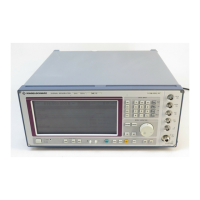Maintenance and Troubleshooting SME
1038.6002.02 4.2 E-13
4.1.3.1 Exchange of RAM Battery
Opening the
instrument
À Remove all cable connections.
À Screw off front panel (4 Phillips screws at the corners) and tilt towards the
front.
The shielding cover (cf. Fig. 4-1) of the controller and the front panel
modules is now freely accessible.
À Detach cable connection to the IEC bus (Fig. 4-1, pos. 3) and to the RS-232
interface (Fig. 4.1, pos. 4). The connection to the motherboard (Fig. 4-1,
pos. 2) can remain plugged in.
À Screw off cover (6 screws (Fig. 4-1, pos. 1)) and lift off.
The computer PCB is now accessible from the top.
Exchanging the
battery
The position of the battery on the computer PCB is evident from Fig.4-2.
ÀDetach jumper X300 (cf. Fig. 4-2, pos. 2).
À Cut off cable tie.
À Unsolder battery.
À Detach cable at plug connector X312 (cf. Fig. 4-2, pos. 1). The remaining
cable connections can remain plugged in.
À Remove 2 fastening screws (cf. Fig. 4-2, pos. 5) on the computer PCB.
À Lift computer PCB and thread new battery clamp.
À Screw on computer PCB (cf. Fig. 4-2, pos. 5), establish plug connection
X312 (cf. Fig. 4-2, pos. 1).
À Fix new battery in position using cable tie.
Caution! Observe the polarity when fixing and soldering the battery (cf. Fig.
4-2 and marking on the PCB). A wrong polarity will lead to the
destruction of components.
À Shorten connection wires to the necessary length and solder battery.
À Plug jumper X300 (cf. Fig. 4-2, pos. 2).
Closing the
instrument
Closing the instrument is effected in the reverse order as opening it.
Caution! Ensure that the braided cord in the casing slots is fitted correctly.

